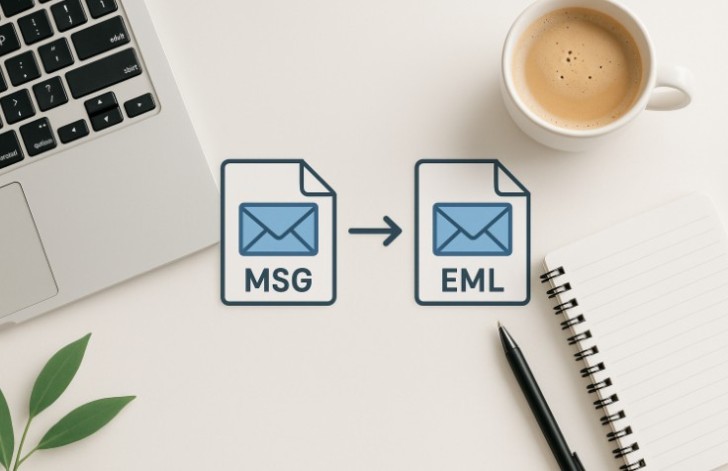Online tools to msg to eml provide essential functionality for converting proprietary Microsoft formats into universally accessible standards. Understanding the technical architecture and benefits of email format conversion enables organizations to optimize their communication workflows while maintaining data integrity throughout the migration process.
Understanding Email Format Architecture
Email messages exist in various formats, each designed to serve specific compatibility requirements and functional capabilities. The evolution from proprietary systems to standardized formats reflects the computing industry's progression toward interoperability and universal access.
MSG Files: Microsoft's Proprietary Solution
MSG files represent Microsoft's approach to storing individual email messages outside the traditional PST container format. These files utilize the Compound File Binary Format (CFBF), creating structured storage that encapsulates comprehensive message data including headers, body content, attachments, and Outlook-specific metadata.
Key characteristics of MSG format include:
- Binary Structure: MSG files use a complex binary architecture that requires specialized parsing algorithms
- Outlook Integration: Seamless compatibility with Microsoft Outlook's advanced features and functionality
- Metadata Preservation: Complete storage of sender information, delivery receipts, and custom properties
- Attachment Handling: Embedded file attachments maintained within the MSG container structure
This proprietary format excels within Microsoft-centric environments but creates compatibility barriers when users attempt to access messages through alternative email clients or cross-platform applications.
EML Format Advantages in Cross-Platform Environments
EML files represent a fundamentally different approach to email storage, utilizing text-based formatting that adheres to established internet standards. The format follows RFC 5322 specifications for Internet Message Format, ensuring broad compatibility across diverse email systems and platforms.
Universal Compatibility Benefits:
- Text-Based Structure: Human-readable format allows direct inspection and modification when necessary
- Standard Compliance: Adherence to MIME RFC 822 protocols ensures consistent interpretation across email clients
- Cross-Platform Access: Native support in Thunderbird, Apple Mail, Windows Mail, and numerous other applications
- Reduced File Size: Text-based encoding typically produces smaller files compared to binary MSG format
EML files excel in scenarios requiring maximum portability and long-term accessibility. Organizations migrating between email systems frequently choose EML format to ensure seamless data transfer without vendor lock-in concerns.
Technical Conversion Process and Data Integrity
Converting MSG files to EML format involves sophisticated parsing and reconstruction processes that must preserve essential email components while adapting to different structural requirements. Microsoft's documentation details the complexities involved in maintaining message integrity across different encoding formats.
Critical Conversion Steps:
- Binary Parsing: Extract message components from MSG's CFBF structure including headers, body, and attachments
- Content Analysis: Identify and preserve formatting elements, embedded objects, and metadata relationships
- Standards Compliance: Reconstruct message data according to RFC 5322 specifications for proper EML formatting
- Attachment Processing: Convert embedded attachments into MIME-compliant base64 encoded sections
Data Preservation During Format Migration
Professional conversion tools maintain complete message fidelity by implementing comprehensive data mapping between MSG and EML structures. This process ensures that critical information remains accessible regardless of format differences.
Essential Elements Preserved:
- Header Information: Sender, recipient, subject, timestamps, and routing data
- Message Body: HTML formatting, plain text content, and rich text elements
- File Attachments: Complete preservation of embedded documents, images, and multimedia content
- Character Encoding: Proper handling of international character sets and special symbols
Advanced conversion systems implement sophisticated algorithms to detect and preserve Outlook-specific features when possible, while ensuring compatibility with EML format limitations.
Cross-Platform Integration Benefits
Converting MSG files to EML format enables organizations to leverage enhanced flexibility in email client selection and deployment strategies. This conversion eliminates dependencies on Microsoft-specific infrastructure while maintaining complete access to historical email data.
Strategic Advantages:
- Vendor Independence: Freedom to choose optimal email clients without format compatibility constraints
- Archive Accessibility: Long-term email storage solutions compatible with multiple platforms and applications
- Migration Simplification: Streamlined transitions between different email systems and service providers
- Cost Optimization: Reduced licensing requirements for Microsoft-specific applications and infrastructure
Organizations implementing email format standardization often experience improved workflow efficiency and reduced technical support requirements. EML format's universal compatibility eliminates common troubleshooting scenarios related to proprietary format limitations.
Key Takeaways:
- Technical Flexibility: EML format provides superior cross-platform compatibility compared to proprietary MSG files
- Data Integrity: Professional conversion tools maintain complete message fidelity during format transformation
- Strategic Benefits: Universal email formats enable vendor-independent infrastructure decisions and long-term accessibility
- Implementation Efficiency: Standardized formats reduce technical complexity and support requirements across diverse environments
Email format conversion represents a critical component of modern information management strategies, enabling organizations to optimize compatibility while preserving valuable communication data across diverse technological environments.
 Editorial staff
Editorial staff

 Editorial staff
Editorial staff


